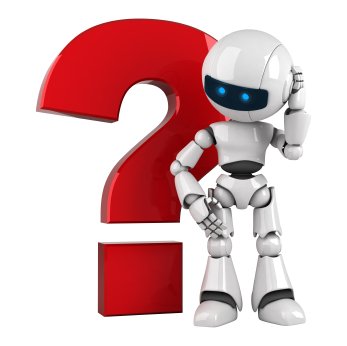All On Robots
Robotics is an interdisciplinary field merging together at least mechanical engineering, electronics engineering and computer science. Often, however, other fields such as biology, cognitive science and others are involved.
The goal of this field is to create robots. Why this is important? Because if you merge mechanical engineering, electronics engineering and computer science to create a printer or an ATM it’s mechatronics.
If you merge mechatronics and biology to research new mechanisms it’s biomechatronics. If, however, you use the same sciences to create a robot it’s robotics. This leads me to this frequently asked question.
What is a robot?

This is a question I’ve heard more than a few times and I’ve thought about it pretty much. There are quite a few definitions around yet I haven’t found a universal definition that would really answer the question.
Some definitions seem quite good at first glance, yet I later realize that these definitions either exclude something we regard as robotic or vice versa – include something we don’t.
1. A mechanical device that sometimes resembles a human and is capable of performing a variety of often complex human tasks on command or by being programmed in advance.
2. A machine or device that operates automatically or by remote control.
“robot.” The American Heritage® Stedman’s Medical Dictionary. Houghton Mifflin Company.
The first one seems OK, right? However, what about Mars exploration rovers? It’s not actually a human task they’re doing. So this definition effectively excludes some devices that are widely perceived as robots. Moreover, CNC machines and ATMs perform complex tasks that were previously exclusively human tasks. Yet, neither CNC machines nor ATMs are regarded as robots or even ‘robotic’.
There are a lot of gray zones like the above mentioned. For example – a car. Although KITT from Knight Rider and DARPA challange cars are usually regarded robotic, most cars are not. However, if a car has an adaptive cruise control, a lane keeping system, an emergency braking system, an electronic stability control, an intelligent parking assist system, etc, then I have to ask – who’s actually the driver. Despite this, it’s still ‘just a car’ while a single microprocessor controlled sumobot is a robot.
In this connection there’s one quote I really like:
I can’t define a robot, but I know one when I see one.
Joseph Engelberger, developer of the Unimate
In my opinion this is the best robot ‘definition’ around. As you can see it’s really more about human perception than engineering.
Historically the word robot itself was created to describe artificial yet sentient workers. You can read more about it in my Robotics history section. So, as I see it it’s actually the illusion of sentience that we judge when making this unconscious decision whether something is robotic or not.
The gauge I usually use when deciding whether to write about something in this site or not is the public opinion. If people regard something as a robot I do too. From this point of view you can say that the site is really about answering the question – what is a robot. This leads me to.
What this site is really about?
Although the name (All On Robots) is quite self explanatory I guess you may still be wondering about the purpose of this site. As you can understand, the site is mainly about robotics (Duh!). In the wider meaning of this word.
It’s not only about ‘robotics’ as in ‘industrial’, or as in ‘robot building’. I talk about these topics too of course. But it’s the phenomenon itself I’m more interested in. I want to discuss and answer questions such as – where it came from, where it’s now and where we’re heading with it. That’s why you can find some philosophical nonsense here and there in this site.
As you can see I try to include the whole robotics spectrum not just one part of it. I really think there’s no other way how to really get a grasp on this concept than to look at the whole picture together.
Also, the types of robots section is there to show you the wide variety out there. There’s really more to it than just industrial and service robots, or wheeled robots and 6-axis arms.
And of course – Robotics History section. Being an engineer with a heart of a historian I really like to get to the bottom of things. There you can find articles on the origin of the term, as well as important milestones in different sciences that have made robotics possible today.
Who am I to write this? I’m a mechatronics engineer and as you may have already guessed – a robotics enthusiast. In my day job I have to deal with technologies that when looking at definitions could be even regarded as robotic yet never are. Technologies that run in the background making our modern lives possible.
Because of this education and job there may be places where I slip into some technical or theoretical debate. I try to keep these to the minimum though and mostly write in a popular scientific way. Speaking about writing.
The Past, the Present and the Future of robotics

There are few places in this site were I can let my inner writer express himself. The history section is one such place. But there is no ‘Robotics future’ section. The reason for this is actually quite obvious – writing about ‘possible’ future scenarios would be science fiction. This site, however, is about real world robotics.
As i don’t have a separate section for such philosophical debate, I’m going to discuss it with you a bit here. I’ve written quite a lot about past, yet the main idea is that people have tried to create alive and sentient (or appearing as such) artificial beings a long time before electronics and computers.
So, it’s not really a modern times only phenomenon, just read about automatons and karakuri ningyo. The impact of karakuri ningyo tradition on japanese robot culture is actually quite significant. As you can see aesthetics and art is an important part of robotics too. So really, I believe that if robot kits would’ve been available in prehistoric times 2 out of 10 cave painters would’ve created robots instead of cave painting.
Today robots aren’t science fiction anymore, sort of. We have robots cleaning our apartments, exploring distant worlds for us and building our cars. However, there are no ‘sentient’ man-made beings around having ‘real’ artificial intelligence.
This brings me to the future. I believe there will be more and more robots (illusionary sentient or just regarded as such) doing something for us in the future. Robots mining helium-3 on the Moon, autonomously building a Mars base, becoming an integral part of search and rescue operations, etc, could all be seen in a foreseeable future.
I also believe that other devices will gradually become more automatic. Cars will probably become more robotic, public transportation without drivers and self-stocking refrigerators could be found in near future too.
The pivotal point, however, would be the creation of real artificial intelligence. Then ethical questions would arise – should we develop robot rights similar to animal rights, or similar to human rights? Can you marry a robot? Should robots be allowed to vote? At the moment though it’s science fiction.
Whether or not we should allow Roombas vote is not something we have to worry about now. We shouldn’t worry about robots now at all. Robotics is an exciting research field with many practical applications and rich educational value.
